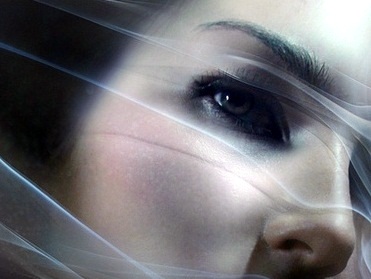
Illusion or Reality?
WHAT we usually call ‘reality’ may actually be completely subjective, as it is filtered through our ordinary physical senses, according to Theosophy.
Yet, “every one of us possesses the faculty, the interior sense, that is known by the name of intuition,” H. P. Blavatsky wrote in her article The Beacon-Light of the Unknown, “but how rare are those who know how to develop it!
“It is an instinct of the soul, which grows in us in proportion to the employment we give it, and which helps us to perceive and understand the realities of things with far more certainty than can the simple use of our senses and exercise of our reason.”
It is only by the aid of this faculty that men can ever see things in their true colors.
“What are called good sense and logic enable us to see only the appearances of things, that which is evident to everyone.

Awakening.
“The instinct of which I speak, being a projection of our perceptive consciousness, a projection
which acts from the subjective to the objective, and not vice versa, awakens in us spiritual senses and power to act.
These senses assimilate to themselves the essence of the object or of the action under examination, and represent it to us as it really is, not as it appears to our physical senses and to our cold reason.”
- H. P. Blavatsky, Le Phare De L’Inconnu

Plato
Plato’s Cave
In a related article “The Subjective and the Objective,” William Q. Judge refers to the Plato’s Cave metaphor:
Socrates: “Imagine the enlightenment and ignorance of our nature in a figure: Behold! human beings living in a sort of underground den, which has a mouth opening towards the light, and reaching all across the den;
they have been here from their childhood, and have their legs and necks chained so that they cannot move, and can only see before them;
“for the chains are arranged in such a manner as to prevent them from turning their heads. At a distance above and behind them the light of a fire is blazing, . . . There can be no question, that the truth would be to them just nothing but the shadows of the images.”

Plato’s Cave
W. Q. Judge: “Theosophy recognizes a continuous gradation of powers, faculties, states, principles — call them what you will — from the highest or most spiritual to the lowest or most material. In this whole gamut of states or conditions, no chasm is found; there is nothing to bridge; consciousness is the necessary substratum and presupposition of the most material, and consciousness is the noumenon or essential reality of the most spiritual.”
We know of nothing more material or external than the physical, material, visible body–the world of matter, so-called …. of the cave which Socrates describes in Plato’s dialogue — the wall upon which fall the shadows supposed by the prisoners to be the only realities.
THE SUBJECTIVE AND THE OBJECTIVE A LESSON FROM THE CAVE OF PLATO’S REPUBLIC, BOOK VII – William Q. Judge

Disappearing into an illusion.
The Bhagavad-Gita
The Hindu poem, a dialogue between Master Krishna and his disciple Arjuna, in the Bhagavad-Gita, is set metaphorically on a ‘battlefield.’ This chosen venue symbolizes “the war within,” which each of us continually faces, an inner struggle we must eventually wage.
(The Theosophy of the Bhagavad Gita)
In Chapter 11, Krishna challenges Arjuna to exercise his spiritual sight in a specially induced vision of “the Divine Form as including all forms.” To enforce the lesson, and in answer to Arjuna’s request, Krishna temporarily awakens his “Divine Eye.” The rest is the drama of the awakening soul.
Read Chapter 11 online:
The Bhagavad-Gita, Chapter 11,
The Vision of the Divine Form as Including All Forms

Krishna and Arjuna on the battlefield.
Temporary Illusions
“Gautama, the Buddha, only remained in solitude long enough to achieve self-awareness, and enable him to arrive at the truth, to which he devoted himself from that time on to promulgate, begging his bread, and living for humanity.”
If, in the words of the dying Buddha, ‘all compounds are perishable,’ then all collections of atoms must be considered but temporary ‘illusions.’
They are such, according to The Secret Doctrine (1:329), because they are the very personal creations “of the perceiving Ego.” But this must not be considered a solipsistic argument. If we only knew how to get past our five material senses would be able to contact the underlying ‘reality’ of physical things. But never in an isolated ‘Me’ universe.

The Me Universe
The term “Ego” here must ultimately refer to a personal state, and as such must always relate to specific ‘states’ of consciousness. But this is only from our plane of perception. According to The Secret Doctrine (1:330), once we have gotten past that plane, and scaled the “peak of Omniscience,” the “knowledge of things-in-themselves” is immediately available to us.

Real motion or the illusion of motion?
Progressive Awakenings
“Whatever reality things possess must be looked for in them before or after they have passed like a flash through the material world; but we cannot cognise any such existence directly, so long as we have sense-instruments which bring only material existence into the field of our consciousness. Whatever plane our consciousness may be acting in, both we and the things belonging to that plane are, for the time being, our only realities.
“As we rise in the scale of development we perceive that during the stages through which we have passed we mistook shadows for realities, and the upward progress of the Ego is a series of progressive awakenings, each advance bringing with it the idea that now, at last, we have reached “reality;” but only when we shall have reached the absolute Consciousness, and blended our own with it, shall we be free from the delusions produced by Maya.”
THE SECRET DOCTRINE Vol. 1, Page 40
One of the best ways to describe what Theosophy is, arts reporter Ali Snow remarked on a Utah Public Radio show, “is to think of it as a kind of fusion of religion and science.”
A desire to prove or to explore some of the mystical forces that made religion work and make the spiritual world work.
A striking example of this kind of fusion is H. P. Blavatsky’s description of how “the sense of sound is the first thing that manifests itself in the universe … in correspondence with colors or sight.”

Colors and Sound
About this sensory synesthetic power Blavatsky wrote:
If you could only see clairvoyantly a person playing a piano, you would see the sound as plainly as you hear it.
“You can even put cotton in your ears—you will see the sound and every little note and modulation that you could not do otherwise. You cannot hear at a distance, but you can see at a distance.”
“You can taste sound, if you like, too. There sounds which are exceedingly acid, and there are sounds which are exceedingly sweet, and bitter, and all the scale of taste, in fact. There is no nonsense, I say it seriously, and you will find it so if you want to know about the super-physical senses.”
Synesthesia
Making reference to this sensory merging (known today as “synesthesia”) she explained: “One would merge into the other. You can taste sound, if you like, too. There sounds which are exceedingly acid, and there are sounds which are exceedingly sweet, and bitter, and all the scale of taste, in fact.”
There is no nonsense, I say it seriously, and you will find it so if you want to know about the super-physical senses.
(The Secret Doctrine Dialogues p. 86)
Alexander Scriabin, a Russian pianist, and composer who was deeply influenced by Theosophy visualized a grand magnum opus which he titled “Mysterium.”
Click the link here or the link below to listen to Nora Eccles, Harrison Museum of Art as three curators describe the exhibit, Painting Music: Enchanted Modernities, and who gives us a personalized tour of the Theosophy promoted power (click below the photo):

Synesthete Elisabeth Sulser
Click to start below:
This interesting phenomenon is demonstrated practically by the multiple senses of a unique synesthete from Zurich, Switzerland named Elizabeth Sulser. A psi investigator writes:
Her particular combination of senses is so unique that she is the only person in the world documented to have it.





